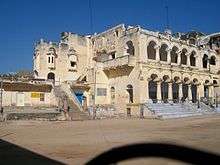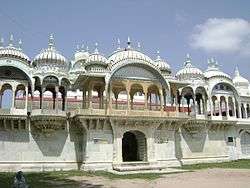Shahpura, Bhilwara
Shahpura is a city and a municipality in Bhilwara district in the Indian state of Rajasthan.[1]
Shahpura | |
|---|---|
Town | |
 Shahpura Location in Rajasthan, India | |
| Coordinates: 25.63°N 74.93°E | |
| Country | |
| State | Rajasthan |
| District | Bhilwara |
| Founded by | Bharat |
| Elevation | 364 m (1,194 ft) |
| Population (2011) | |
| • Total | 30,320 |
| Languages | |
| • Official | Hindi |
| Time zone | UTC+5:30 (IST) |
| Vehicle registration | RJ 51 |
Governance
Shahpura is a Municipality city in the district of Bhilwara, Rajasthan. The Shahpura city is divided into 25 wards for which elections are held every 5 years.
The municipality supplies basic amenities including water and sewerage. It is authorized to build roads and impose property taxes.
Demographics
In 2011 the Shahpura Municipality had a population of 30,320 of which 15,279 are males and15,041 are females.[2]
Children between the ages of 0-6 number 3997 or 13.18% of the total. The female Sex Ratio is of 984 against state average of 928. The child sex ratio is around 929 compared to state average of 888. The literacy rate is 77.84% higher than state average of 66.11%. The male literacy is around 87.47% while female literacy rate is 68.14%.
Shahpura municipality hosts 5,671 households.
Religion
The population is 79.83% Hindu, 18.36% Muslim, 0.03% Christian, 0.04% Sikh and 1.71% Jain. Ancient temples are part of people's daily life there.
Economy
As of 2011 9,986 residents were engaged in work or business, including 7,685 were males and 2,301 females. 89.36% were engaged in main work while 10.64% were engaged in marginal work.
History

Shahpura is known as the jagir (estate) of Surajmal, second son of Maharana Amir Singh I; their title is 'Raja Dhiraj'. Surajmal had two sons, Sujan Singh and Veeramdeo. During Shah Jahan's period, Sujan joined the service of the Emperor, who gave him the district of Phoolia and a mansab (military posting) of 800 Jat (foot soldiers) and 300 Sawar (horse or horsemen). In 1643, Sujan Singh's mansab was raised to 1,000 Jat and 500 Sawar, and in 1645, to 1,500 Jat and 700 Sawar. Later, he went to Kandahar with Mughal Prince Aurangzeb and, in 1651, his mansab grew to 2,000 Jat and 800 Sawar.
When Shah Jahan sent his army, under the command of Saddulla Khan, to Chittor to demolish a wall that had been restored in contravention of the 1615 treaty (see Amar Shingh I, Maharana), Sujan Singh was with him. To avenge Sujan's ungrateful act, Maharana Raj Singh I attacked Shahpura (1658) and exacted a penalty of Rs. 22,000/-. Maharana Raj Singh also burnt the area governed by Veeramdeo. Later, Shah Jahan sent Sujan to Dharmat to assist Maharana Jaswant Singh in his fight against the rebellious Prince Aurangzeb. There, Sujan died with his 5 sons.
Veeramdeo left the Maharana and joined Shah Jahan, where he received a mansab of 800 Jat and 400 Sawar. He fought bravely in the Kandahar expeditions and his mansab was raised to 3,000 Jat and 1,000 Sawar. At the battle of Samugadh, Veeramdeo was in the first flank of Mughal Prince Dara's force against Prince Aurangzeb. After Dara was defeated, Veeramdeo went over to Aurangzeb. Later, he was sent to Assam with Ram Singh of Jaipur. After this, he returned to Mathura with Safshikan Khan, where he died around 1688.
Fateh Singh, elder son of Sujan Singh was also killed at Dharmat, and Fateh's son, a minor, succeeded him. Six years later, Sujan's fourth son, Daulat Singh, usurped Shahpura and became its ruler. (Fateh's descendants are now at Gangwas and Barliawas.) When Aurangzeb attacked Maharana Raj Singh, Daulat was in the Mughal army. Daulat's son, Bharat Singh, fought for Maharana Sangram Singh II in the battle against Mewati Ranbaj Khan. Bharat was imprisoned by his son, Umaid Singh, and died in prison.
Umaid Singh wanted his younger son Zalim Singh to be his successor; to do this, he poisoned his elder son, Udyot. He even wanted to kill his grandson (i.e., Udyot's son) and sent a soldier to commit the act. The soldier struck but missed, only wounding him. At that moment, Ran Singh's son, Bhim Singh, aged only 14, killed the soldier, and Umaid's dream to make Zalim his successor was foiled.
Many of Mewar's nobles were against Maharana Ari Singh II (1761-1773). Ari Singh wooed Umaid Singh to his side and gave him the Paragna Kachola (District of Kachola). Umaid died at Ujjain, fighting for the Maharana against Madhav Rao Sindhia. In 1869, Nahar Singh, who had been adopted, became the ruler of Shahpura (he had been the son of Balwant Singh of Dhanop). In 1903, the British awarded him the K.C.I.E., and entitled him to a 9-gun salute. He became a member of the Mehdraj Sabha. Later, he refused to go into the service of Maharana Fateh Singh, claiming to be an independent ruler. However, the British ruled that he would have to comply, every second year, and pay Rs. 1 Lakh to the Maharana as a penalty for not attending his court.
Ram Snehi

Shahpura is a place of pilgrimage for the followers of the Ram Snehi sect. They have a shrine in the town called Ramdwara. The chief priest there is the head of the sect. Pilgrims from across the world visit the shrine. A fair called Phooldol Mela continues for five days after Holi. by Ramdwara Temple.
Charbjuja Temple
The temple of Charbhuja Nath is situated in the middle of the city, as well as a Hanuman Temple called Balaji Ki Chatri.
Eight Prachin Jain Temples including four Swetamber Sampradaya and four Digamber Sampradaya.
References
| Wikimedia Commons has media related to Shahpura, Bhilwara. |
- "Shahpura | India". Encyclopedia Britannica. Retrieved 13 September 2019.
- "Census of India Website : Office of the Registrar General & Census Commissioner, India". www.censusindia.gov.in. Retrieved 10 September 2019.